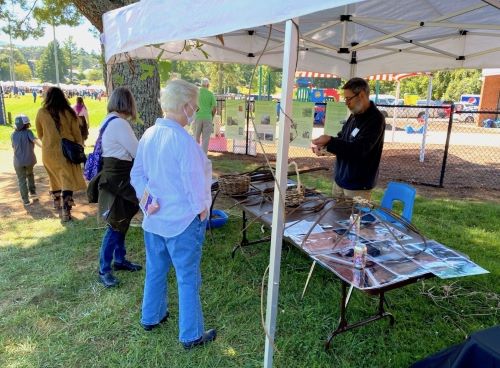Baskets woven and rope created from the South’s most hated vine – kudzu. Visitors of this year’s Mountain Heritage Day got to learn all about what one can make from it.

Mountain Heritage Day went off with a blast this year. More people came than expected especially with COVID-19 protocols for social distancing still in place for WCU campus. The previously estimated number of around 10,000 visitors was surpassing. Peter Koch, the educator for the Mountain Heritage Center, said there were more than 12,000 enjoying the nice day of festivities.
One of the more popular parts of a festival are the crafts. Mountain Heritage Day has two different craft sections.
The vendor side of crafts has to pay for a spot at the festival. After they pay for a spot, there is a committee that looks over their products to make sure they are handmade. They look to see if the supplies used are real, locally gathered and not made of plastic.
The demonstration side is different. These artists are searched for by the Mountain Heritage Center to come and share their craft with others.
“I really look for people on how they learned and if they can teach others their work,” Koch said.
Demonstrators are practitioners of a craft that they learned. They are paid to came and share their craft with others. There were 13 demonstraters at Mountain Heritage Day. It ranged from basketry to quilt making, blacksmiths and coppersmiths, all the way to carving and tractor rides.
One memorable demonstrator was, Jeffrey Gottlieb, a Kudzu craft maker who has demonstrated his skills in past festivals and was happy to come again this year.
Kudzu crafts are different things made from kudzu plants. It is used to create baskets, sturdy rope, and even building materials that Gottlieb used to create the second known kudzu bale building.
Kudzu is a plant that came from Japan. It helped stabilize eroded areas and restore depleted soils. It turns out that the red soil found throughout the south makes it grow, it grows a foot a day quickly became a troublesome, invasive weed.
Even though it is troublesome people decided to put it to good use.
“Kudzu has uses as medicines, foods, paper making fibers, building materials and much more,” Gottlieb said.
Gottlieb moved here 10 years ago from Long Island, New York, he studied primitive living skills and wilderness survival for years. He said it was natural to study rope making and plant fibers.
For more crafts like Gottlieb visit Mountain Heritage Center to learn more. MHC has a River Can Renaissance exhibit until Dec. 10. They also have a permanent exhibit Discovering Appalachia.


